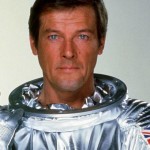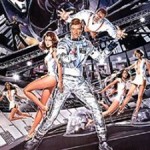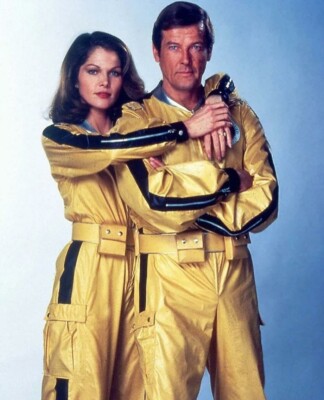![Hugo Drax (Michael [Michel] Lonsdale)](https://www.007.info/wp-content/uploads/2012/05/MRVillainHugoDrax4.jpg) Loosely based upon Ian Fleming’s third best-selling novel, the James Bond film Moonraker (1979), the eleventh EON 007 production, was a spectacular movie in every meaning of the word. While the late Sir Roger Moore often named The Spy Who Loved Me as his all-time favourite Bond movie, which in many ways had revitalized a flagging franchise, Spy was swiftly followed by Moonraker, as producer Albert ‘Cubby’ Broccoli sought to build upon the huge visual and escapist dynamism of Spy and take Bond into ever-more exotic locations and even into outer space.
Loosely based upon Ian Fleming’s third best-selling novel, the James Bond film Moonraker (1979), the eleventh EON 007 production, was a spectacular movie in every meaning of the word. While the late Sir Roger Moore often named The Spy Who Loved Me as his all-time favourite Bond movie, which in many ways had revitalized a flagging franchise, Spy was swiftly followed by Moonraker, as producer Albert ‘Cubby’ Broccoli sought to build upon the huge visual and escapist dynamism of Spy and take Bond into ever-more exotic locations and even into outer space.
Roger’s fourth outing as Ian Fleming’s iconic secret agent 007, directed again by Lewis Gilbert, began shooting in 1978 and co-starred Michael Lonsdale as the space-obsessed villain Sir Hugo Drax and Lois Chiles as space scientist Holly Goodhead. The movie also saw the return of Richard Kiel as ‘Jaws’, who had proved to be such a popular feature of The Spy Who Loved Me with cinema audiences that Bond Producer Cubby Broccoli decided Kiel should reprise the role for the next James Bond movie.
Interestingly, the Bond Producer originally contemplated having For Your Eyes Only as the next 007 adventure and, indeed, the end credits of The Spy Who Loved Me in 1977 had announced that ‘James Bond will return in For Your Eyes Only‘. However, in the wake of the massive Star Wars phenomenon at the box office in 1977, and also the mounting excitement over the USA’s developing Space Shuttle project, Broccoli and his advisers at EON decided that it made more sense to go for a ‘science fiction’ dimension to the next film, but also to root it in ‘science fact’.
Moonraker’s Origins
There is no doubt that Bond creator Ian Fleming borrowed much of his inspiration for his novels from his own wartime service in Naval Intelligence and, in particular, his formation of a special commando unit that sought out and captured Nazi rocket technologies and other new scientific inventions. This is very evident in Fleming’s Bond adventure Moonraker (1955). Ian Fleming’s third 007 novel was a fast-paced story set over a short period of time and had at its heart, the development of a special rocket project for the British Government in the 1950s. It was to be Britain’s first nuclear missile, based on an upgraded version of the infamous German wartime ‘V-2’ rocket, and part-financed by the rather mysterious multi-millionaire businessman and card-cheat Sir Hugo Drax. Drax, who was assumed by the British Government to have been a British soldier in the War, was in fact a secret former Nazi who was about to turn the new missile on its UK sponsor and launch it directly at London – until he was thwarted, of course, by James Bond and Gala Brand.,
A New Approach
EON decided that this central theme could still be the basis of a radically re-imagined new story which would see James Bond actually go into outer space. Instead of a 1950s-style UK-based storyline, the movie was very modern and hi-tech in its approach, and presented cinema audiences with a plot that coould easily be rooted in the near future. However, the ‘Nazi’ dimension to Fleming’s original storyline was indirectly retained in the Moonraker screenplay, with Drax having a plan to re-populate the earth with a new ‘Master Race’, and Michael Lonsdale was able to turn in a genuinely creepy performance as the deranged Sir Hugo. The fear of ‘terror’ weapons was also a key theme in the movie, but this time via chemical warfare.
Production
For financial and tax reasons, the main production of Moonraker was switched from Pinewood Studios in the UK (Bond’s ‘traditional’ 007 production home) to studios in France, where the award-winning set designer Ken Adam was able to build some of the largest sets ever built in a French studio up to that point. The production team on Moonraker were also given special access by NASA to the Space Shuttle project in America and also to previews of design plans for possible future space stations, and there were high hopes on both NASA and EON’s part that the release of the movie would more-or-less coincide with the official launch of the first Space Shuttle. But the movie, which was premiered in the UK on 26th June, 1979, in fact jumped ahead of the official American Space Shuttle programme. The first NASA Shuttle (Columbia), due to launch in 1979, had developed teething problems with some of its components, and, in the event, was not launched until 12th April, 1981.
Highpoints
While the film tended to water down some of its tension with too many ‘carry on’ style moments, and some of the product placement became too obvious, there were still some genuinely ‘Bondian’ sequences and, arguably, more than enough to satisfy both 007 fans and general cinema audiences. A visually stunning pre-credits sequence, involving Bond fighting in mid-air for a parachute, kicked off the movie in a spectacular way. Bond’s initial encounter with Sir Hugo Drax and the mutual dislike that quickly develops between the two central characters also showed Moore and Michael Londsdale at their screen best, which set the tone for their subsequent encounters in the film. Lonsdale was a very good choice for the role of Drax, and was given some very satisfying dialogue: ‘Look after Mr. Bond. See that some harm comes to him’; ‘James Bond – you appear with the tedious inevitability of an unloved season’; and so on.

Bond’s near demise in the space centrifuge also had audiences genuinely squirming, while the fight between the henchman Chang and Bond in the Venice Glass Museum was a highly visual and suitably loud confrontation, one that fitted superbly to the big screen. Other memorable sequences included the visually beautiful, if horrific, chase and death of Corrine Dufour via the savage jaws of Drax’s dogs, and a major Thunderball-style space battle between the laser-wielding U.S. space marines and Drax’s men both outside and inside the space-station, while Bond’s attempts to use his space shuttle to destroy the deadly glass globes that Drax has sent to wipe out the earth’s population proved to be highly tense second climax to the movie.
All this was helped by the design genius of Ken Adam and some truly inspired music from 007 veteran John Barry, together with support from the regular and familiar Bond office team: Miss Moneypenny (Lois Maxwell), ‘Q’ (the ever-popular Desmond Llewelyn), and ‘M’ (Bernard Lee, in what was to be, sadly, his final appearance as Bond’s MI6 boss). Walter Gotell and Geoffrey Keen also made return appearances.
Reception
Although Moonraker received mixed reviews from the critics upon its release in 1979, the movie stormed box offices around the world and proved to be very popular with cinemagoers. The sets, model-work and visual designs of the movie were particularly praised, and the special visual effects team of Derek Meddings, Paul Wilson and John Evans were nominated for an Academy Award for Best Visual Effects. John Evans and John Richardson were also nominated in 1980 for a special Saturn Award for their special effects work on Moonraker. Richardson went on to become Special Effects supervisor on Octopussy (1983) and A View To A Kill (1985).

Cubby Broccoli, realising EON had pushed the ‘fantasy’ element about as far as they could go with Moonraker, decided that the next movie in the franchise, For Your Eyes Only (1981), would bring Bond very much back down to earth, with a grittier and more story-driven plot. But, in terms of sheer excess and exotic locations, Moonraker remains a highly entertaining entry in the 007 franchise, and many Bond fans were introduced to the big-screen world of 007 via their first viewing of Moonraker.
The influence of both Fleming’s book and the EON movie can also be seen in subsequent Bond movies, especially in Pierce Brosnan’s last adventure as 007, Die Another Day (2002). Neal Purvis and Robert Wade, the screenwriters on the movie, employed a number of unused elements from Fleming’s novel Moonraker, including the London Blades Club. The main villain, Gustav Graves, was also arguably modelled on Sir Hugo Drax. Interestingly, Rosamund Pike, who played MI6 agent Miranda Frost in Die Another Day, has confirmed that she was originally to have played a character named Gala Brand.
Some story concepts originally developed for the Moonraker screenplay, but then dropped, were re-used in later Roger Moore Bond movies, the best examples of this being a sequence with some microlight jets (reworked for Octopussy) and a scene at the Eiffel Tower in Paris (which was eventually used in A View To A Kill).
Did You Know?
The famous and spectacular fight in Moonraker between Bond and Drax’s bodyguard Chang (Toshiro Suga) in the Venetian glass museum, was shot at Boulogne Studios (a former German wartime aircraft factory) and set a new record for the largest amount of break-away glass (sugar glass) used in a single movie scene up until that point. At the time, sugar glass was a perfect and popular choice for stunts, although could still lead to occasional accidents if not planned and used carefully. Since then, however, sugar glass has largely been replaced by safer synthetic resins for such stunt work in movies.

Lois Chiles and Roger Moore pose for a publicity photo for ‘Moonraker’.
